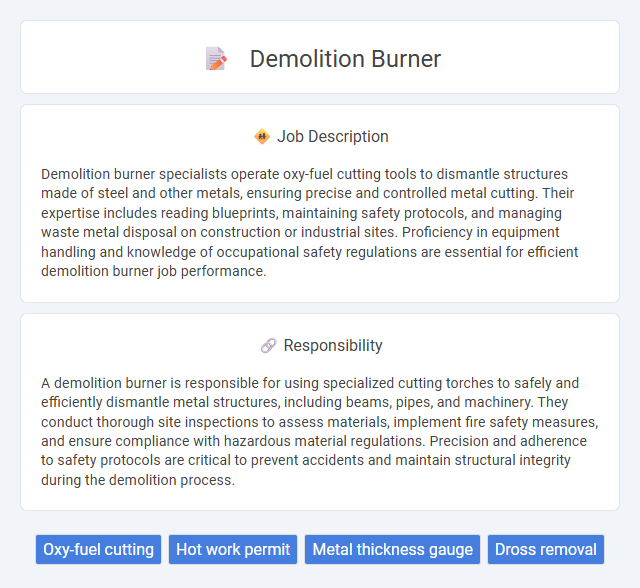
Demolition burner specialists operate oxy-fuel cutting tools to dismantle structures made of steel and other metals, ensuring precise and controlled metal cutting. Their expertise includes reading blueprints, maintaining safety protocols, and managing waste metal disposal on construction or industrial sites. Proficiency in equipment handling and knowledge of occupational safety regulations are essential for efficient demolition burner job performance.
Demolition burner work typically involves exposure to high temperatures, heavy machinery, and hazardous materials, which may not be suitable for individuals with respiratory issues or limited physical stamina. People who are physically fit, able to work in demanding environments, and comfortable with handling intense heat and potentially dangerous conditions are more likely to succeed in this role. It is probable that those lacking proper safety training or coping skills for stressful situations might find this job unsuitable.
Qualification
Demolition burner jobs require specialized qualifications, including certification in oxy-fuel cutting and welding, along with extensive experience in handling demolition tools and equipment safely. Candidates must possess strong knowledge of safety protocols, hazardous material handling, and structural dismantling techniques to ensure efficient and secure operations. Proficiency in reading technical blueprints and adherence to OSHA standards are critical qualifications for success in this role.
Responsibility
A demolition burner is responsible for using specialized cutting torches to safely and efficiently dismantle metal structures, including beams, pipes, and machinery. They conduct thorough site inspections to assess materials, implement fire safety measures, and ensure compliance with hazardous material regulations. Precision and adherence to safety protocols are critical to prevent accidents and maintain structural integrity during the demolition process.
Benefit
Demolition burner jobs likely offer the benefit of high demand due to ongoing construction and renovation projects requiring specialized skills in cutting and dismantling metal structures. Workers may experience competitive wages and opportunities for overtime, reflecting the hazardous and technical nature of the work. Safety training and certifications obtained on the job could enhance future employment prospects within industrial and construction sectors.
Challenge
Demolition burner jobs likely present significant challenges due to the requirement of handling intense heat and working in hazardous environments. The probability of facing unpredictable structural weaknesses and confined spaces may increase the difficulty and risk involved. Workers must remain highly alert and skilled to manage these factors safely and effectively.
Career Advancement
A demolition burner operates specialized equipment to cut through metal structures in demolition projects, requiring precision and safety expertise. Gaining certifications such as OSHA safety training and welding qualifications can significantly enhance career prospects and salary potential. Experienced demolition burners often advance to supervisory roles or transition into construction management, offering broader responsibilities and improved job security.
Key Terms
Oxy-fuel cutting
Demolition burner operators specialize in oxy-fuel cutting, a process utilizing oxygen and fuel gases like acetylene or propane to generate a high-temperature flame capable of precisely cutting through thick metal structures. They control flame temperature and cutting speed to maximize efficiency and ensure clean, accurate cuts during building demolition or industrial dismantling. Expertise in handling oxy-fuel equipment and safety protocols is critical to prevent hazards such as gas leaks and to optimize the demolition workflow.
Hot work permit
Demolition burner jobs require strict adherence to safety protocols, especially the issuance of a hot work permit to control fire hazards during cutting and welding operations. The hot work permit process includes identifying potential ignition sources, ensuring proper fire watch, and providing adequate ventilation to prevent sparks and flammable gas accumulation. Compliance with OSHA and NFPA standards reduces risks, safeguards workers, and maintains site safety throughout the demolition activities.
Metal thickness gauge
Demolition burner operators rely heavily on precise metal thickness gauges to assess the integrity of materials before cutting, ensuring safety and efficiency during metal dismantling. These gauges provide accurate measurements of steel and other metals, preventing accidental breaches and optimizing the cutting process. Utilizing advanced ultrasonic or magnetic thickness gauges helps demolition professionals maintain structural awareness, reduce risks, and enhance the quality of metal removal operations.
Dross removal
Demolition burners play a crucial role in efficiently removing dross, which consists of oxidized metal residues formed during welding and metal fabrication processes. These specialized burners use controlled combustion to burn off the dross, ensuring clean metal surfaces and preventing defects in subsequent manufacturing stages. Effective dross removal enhances the quality of metal products and reduces the need for extensive mechanical cleaning or grinding.
 kuljobs.com
kuljobs.com